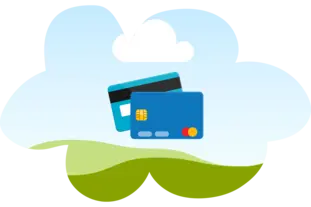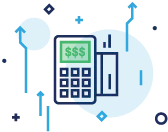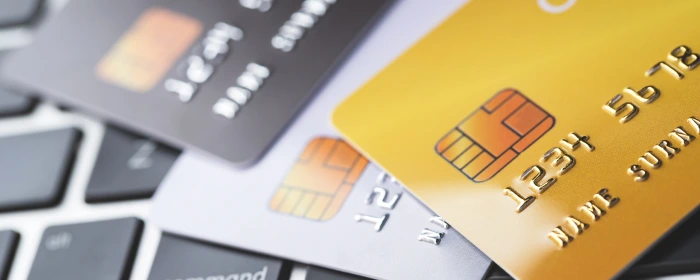
TABLE OF CONTENTS
- What Is Credit Card Processing?
- How Does Credit Card Processing Work?
- The 5 Main Steps of the Credit Card Transaction Process
- Credit Card Processing Fees
- Credit Card Compliance
- Types of Credit Card Processing Equipment
- How to Choose a Credit Card Processor
- Credit Card Payment Processing: Closing Remarks
- FAQs
What Is Credit Card Processing?
Credit card processing is the process through which businesses accept credit and debit card payments from their customers. If you’ve shopped at a store using a debit or credit card, you may think it’s as simple as swiping or tapping. However, a lot goes on behind the scenes to ensure transactions are processed safely and securely.
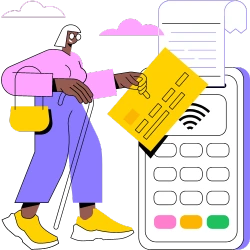
Credit card processing encompasses the events between a customer swiping their debit or credit card and you receiving the payment in your account. A credit card processor assists with scanning and authorizing a card and reviewing it for fraud. After funds are exchanged, the payment is settled. This process applies to cards accepted in-person, online, or over the phone.
Service Provider Types
This process is not as simple as downloading an app or buying a machine and plugging it in. To accept cards through that machine, you’ll need to connect it to a credit card processor. There are many types of credit card processors, but the three most common are banks, payment services providers (PSPs), and merchant services providers (MSPs). Of the three, merchant service providers are usually the most direct and reputable option and tend to have the lowest rates and fees. That’s because merchant services providers focus only on helping businesses find the best solutions for their business environment and cater their services and equipment to you.
Credit Card Payment Types
Credit card payments can be broken down into a few categories.
There are:
- Debit vs. credit card payments
- Business card vs. consumer card payments
- Card brand-specific payments (i.e., Visa, MasterCard, Discover, American Express, etc.)
- Entry mode-specific payments (i.e., in person, over the phone, online, mobile, etc.)
How Does Credit Card Processing Work?
Credit card processing is more than meets the eye. Customers who tap or swipe their card don’t always recognize that an entire ecosystem works behind the scenes to give them that approval (or decline) message. Several parties are involved in the five steps to process a transaction from swipe to completion. The process is typically completed in a few seconds. This article will examine this process and put you on the path to accepting payments at your business.
Who are the Parties Involved?
As previously mentioned, credit card processing takes just a few seconds, but six primary parties are involved in the process. These include:
- The business the transaction is running through (i.e., you, the merchant)
- Your customer (i.e., the cardholder)
- Your credit card processor (i.e., the merchant services provider)
- Your customer’s bank (i.e., the card issuer)
- Your bank (i.e., the acquirer)
- And your customer’s card brand (i.e., if the card has a Visa logo on it, then Visa is the card brand involved in the transaction)
Let’s go through each of their roles:

Your Business (The Merchant)
The first and most obvious party involved is your business. You offer a product or service to your customers in exchange for their money. In this context, you’re a “merchant.”

Your Customer (The Cardholder)
The next party is your customer who makes a purchase using a credit or debit card. In this context, your customer is a “cardholder.”

Your Credit Card Processor (Payment Processor)
To set processing fees and agreements, you will sign a contract with a credit card processor, who then routes transactions by facilitating data transfer between you and your customer.

Your Customer’s Bank (The Card Issuer)
Your customer’s credit or debit card links to a bank account with a large bank like Wells Fargo or a small bank like a credit union. The bank that houses the account is known as the “card issuer” because they issued your customer the credit or debit card.

Your Bank (The Acquirer)
A bank houses your business bank account, which allows you to receive funds at the end of a transaction. This bank, the “acquirer,” can be a large business like Wells Fargo or a small operation like a credit union.

Your Network (The Card Brand)
The network or association, also known as the card brand, is the brand of your customer’s credit or debit card. Besides being hosted by a bank, Visa, MasterCard, Discover, or American Express also sponsors your customer’s card.
The 5 Main Steps of the Credit Card Transaction Process
As we’ve touched on, credit card processing is a series of steps that happen as soon as a card is swiped or tapped. Each party involved is responsible for at least one step in the process, which we examine below.

Authorization
The first step is authorization. An authorization is focused primarily on confirming the requested funds are available.
The customer comes to the register (or checks out online) with a cart full of goodies and presents their card for payment. The card gets entered, tapped, swiped, or dipped, and their information goes through a quick fund verification.
Your machine, connected to your merchant services provider, grabs the card information and pairs it with the transaction amount. Your provider sends it in a neat package to the customer’s bank account to verify they have available funds.

Authentication
The second step happens simultaneously, and it’s called authentication. In contrast with authorization, authentication focuses on confirming the cardholder’s identity to prevent fraudulent use of the card in question.
Each transaction will undergo some level of verification. Examples include confirming that the name on the card matches the account holder’s name, that the card number entered matches the card issued and attached to the bank account on file, etc.
A more in-depth authentication process can confirm the correct PIN and ZIP code were entered and send a one-time verification code to a mobile device.

Batching
Once authorization and authentication are complete, you will be left with the equivalent of an IOU in the form of an authorization code. These codes batch together throughout the day.
This batch of suspended transactions gives you a chance to review. For example, this is an opportunity to make tip adjustments or cancel duplicated transactions. After review, you can start batching, which sends your authorization codes to your merchant services provider to initiate the fund transfer (settlement).

Settlement
Your customer will see a pending charge on their bank account throughout the day. Once you have closed your batch, you initiate settlement, which transfers funds through your merchant services provider or your merchant account.

Funding
Once everything is processed, your merchant services provider funds your business bank account with the funds for the day. The process from batch closure to funding can take anywhere from 24 to 120 hours. Your exact funding timeline will vary depending on things like:
- The inherent risk of your business
- Your agreement with your processor
- Your processing history
Credit Card Processing Fees
On average, credit card processing fees are around 3% of your total credit and debit card volume. If you process $100 of debit or credit cards for the day, you can expect to pay around three dollars in credit card processing fees.

Transaction Fees
As we touched on, quite a few parties are involved in credit card processing from start to finish. Each party receives a piece of that ~3% fee you’re charged for running the transaction. You only pay fees to your merchant services provider, but other fees are involved.
You can expect to pay three main types of fees for each transaction. Your merchant services provider will package these fees differently based on the pricing model in your agreement (more on that next). The underlying transaction cost stays relatively consistent regardless of your processor or pricing structure.
Here are the three main fee categories:

Interchange Fees
Visa, MasterCard, and Discover set the interchange rates across the board. These rates comprise about 60% of your total fees. There are roughly 300 different interchange categories under which each transaction could fall. [1]Investopedia. “Interchange Rate: Definition, Calculation Factors, Examples.” Accessed February 21, 2024. The exact rate your transaction qualifies for depends on how the transaction was processed, what type of card was used, and whether or not the card was physically present during the transaction.

Association Fees
The next biggest chunk of fees you pay (usually about 20-30% of the total fees) are called association fees. These fees go to the card brands (Visa, MasterCard, and Discover). [2]Investopedia. “Bank Card Association: What It is, How It Works – Investopedia.” Accessed February 21, 2024. Some association fees are charged on every transaction, regardless of any factor. Others are charged on a per-transaction or occurrence basis. For example, processing a MasterCard issued by a bank in another country will trigger a “cross border” fee in addition to the static fees.

Processing Fees
The final chunk of fees you pay (whatever is left over) goes to your payment processor. This chunk of fees covers the cost of facilitating transactions, overhead for your payment processor, and ongoing data security. These fees can take all sorts of shapes and sizes, including annual fees, monthly fees, per transaction fees, percentage/basis-point markups, etc.
These fees will vary from processor to processor and thus may be where you find savings between providers.

Pricing Models
The underlying cost of processing transactions, as we touched on, stays relatively consistent from processor to processor. The only variance comes from the “processing fees” section of the total fees. The pricing model differences make this variance hard to identify and compare between providers.
Here are the main pricing models:
- Interchange Plus. Interchange Plus is a transparent, yet occasionally confusing, pricing structure. It passes through all the fees at cost and adds a disclosed processing fee on top. It’s essentially like getting an itemized receipt with many line items.
- Flat Rate. Flat Rate is straightforward because you are charged one flat rate, but this model is more cryptic upon examination. This is because it’s impossible to tell the actual processing cost versus what the payment processor keeps as profit on their account. This pricing structure is popular with payment service providers (PSPs) like Square, Stripe, and PayPal.
- Tiered. The tiered pricing structure offers a model balancing transparency and ease of use. Instead of charging one flat rate for all transactions, tiered pricing breaks them down into three or four tiers or rates. Typically, you’ll see a debit rate, a qualified rate, a mid-qualified rate, and a non-qualified rate. It’s not quite as itemized as the interchange pricing model but offers more transparency than the flat rate price.
Credit Card Compliance
Next, let’s touch on compliance. Payment processing is, by nature, a risky process. While there are additional security benefits to using debit or credit cards over cash, such as the ability to retain funds if the card is lost, there is an inherent risk of theft and fraud. To prevent this, a regulatory board known as the Payment Card Industry Data Security Council meets to set rules and regulations.[3]Payment Card Industry Data Security Council. “PCI Security Standards Council”. Accessed February 21, 2024. As a merchant, you agree to abide by the advisory board’s security standards.
Let’s dive into how you can do that.

PCI Compliance
You are PCI Compliant (also known as PCI DSS compliance) when you certify your adherence to the comprehensive standards set by the PCI Security Standards Council. Failing to meet these standards can come with exorbitant costs, which is crucial.
You must certify your compliance yearly by completing a self-assessment questionnaire customized to fit your business environment. It will verify things like your processing habits, security setup, card number storage process, that people who shouldn’t have access to card numbers don’t, and that employees have been sufficiently trained.
You’ll want a credit card payment processor that is both compliant with these standards and willing/able to help you certify your compliance.

Electronic Funds Transfer Act (EFTA)
The Electronic Fund Transfer Act of 1978 was drafted to “protect individual consumers engaging in electronic fund transfers.”[4]Federal Reserve. “ELECTRONIC FUND TRANSFER ACT”. Accessed February 21, 2024. This act limits customers’ losses from unauthorized money movement. It’s essentially the foundation of all consumer protections in this space.
The protection of consumers is paramount, making it crucial for card issuers, card brands, merchants, and all relevant parties to handle data with utmost care. In the unfortunate event of a data breach, the merchant is responsible. In case of any mishap, obtaining PCI compliance certification is your primary defense mechanism.
Types of Credit Card Processing Equipment
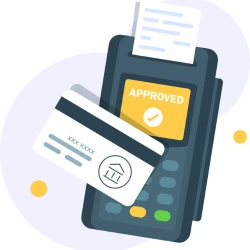
Now, let’s talk equipment. To process debit and credit cards, you need a merchant account that connects you to the payment networks. These networks facilitate transactions between banks. You also need a device connected to that merchant account that allows you to accept customer payments.
Processing equipment encompasses hardware (i.e., physical devices), software (i.e., completely digital), and POS systems that combine both.

POS Systems
Point of Sale (POS) software systems are the gold standard in restaurants and retail establishments. They handle credit card payment processing as a small piece of their overall role on-site. They can also help manage inventory and coordinate between the front and back of the house.
They’re also perfect for collecting customer information for long-term retention. They come in many forms, so thoroughly research your POS system before purchasing to ensure it has all the features you need to run and scale your business.

Terminals/EMV Readers
You probably think of this when you hear “credit card machine.” A terminal is the countertop device you see at most businesses. It has a small screen and keypad that swipes/taps/dips the card and gives a simple approval or decline message.

Mobile/Wireless Terminals
Mobile and wireless terminals have become increasingly popular because of their ease of use and portability. They’re perfect for pop-up stores, farmers’ markets, and on-site services (like home cleaning, electricity, or plumbing).
Mobile is just like it sounds – payments are processed through a mobile device (usually a smartphone). This term means your smartphone becomes the terminal. To access it, you log into an account from your device using an app or web browser. This account connects you to your processor to process transactions. These transactions have two options: manually key them into the app or swipe/tap/dip them through a physical device attached to your smartphone.
Wireless devices are similar, except they don’t use your cell phone – they are a piece of hardware in their own right. These devices are similar to a countertop terminal (the traditional machine you’ll still see on countertops), but they are wireless and don’t require any cords. They use a rechargeable battery, WiFi, or 3G/4G connection to operate.

Virtual Terminals
Virtual terminals are a credit card payment processing software-only solution. They run entirely online. Because of this, you can access them by logging into a secure portal (or online payment interface) from any internet-connected device.
A virtual terminal allows you to quickly process single (as well as recurring) transactions directly through the portal. In a virtual terminal, you can enter the card data (obtained via phone or through a payment authorization form).

Payment Gateway
A payment gateway often gets confused with a virtual terminal because both technologies are used behind the scenes to process payments. There are a few key differences between the two, however.
A payment gateway is the technology behind an online website shopping cart. The main difference is that your customer enters their payment information.
How to Choose a Credit Card Processor
Now that you’re more familiar with how credit card processing works and what equipment you’ll need, it’s time to find a processor that serves your business.
You can choose from a few common payment service vendors to connect you to the payment networks. These include payment service providers (PSPs), merchant service providers (MSPs), and banks.

Merchant Service Provider vs Payment Service Provider
Everyone’s pretty familiar with the idea of a bank, so we’ll skip defining that one. Despite promises of faster funding and a strong existing relationship, securing a merchant account through your business’ bank is generally not advisable. There is a great deal of risk in the owner of your debts controlling your income, as you end up with fewer options in the event of trouble (like account freezing, diverting funds to pay themselves back first, or account closure).
A merchant service provider (MSP) is a wholesale full-service payment processor. MSPs connect you to your merchant account, give you a merchant ID, and primarily focus on payment services.
On the contrary, a payment services provider (PSP) functions as a retail service provider, reselling access to their merchant account rather than providing you with your own. This implies that you won’t have your merchant account, merchant ID, or customized payment solutions if you opt for a PSP.
Companies Like Square, Stripe, and PayPal are payment service providers (PSPs). These solutions have advantages such as ease of setup and the ability to be up and processing on the same day. At the same time, disadvantages include higher processing costs and a lack of customization. On the other hand, a wholesale provider takes longer to set up because of their full underwriting process but tends to offer more custom solutions, support, and fewer account restraints.
Here’s what to look for in a good merchant services provider:

Integration Support
One of the first things you should consider when comparing merchant service providers is their integration capacity and support. You likely have several systems already set up in your business. Finding a provider who seamlessly fits those existing systems will make your life easier.
Each merchant services provider should have a page on their website dedicated to their available integrations, or you can ask the sales representative directly for more information. Common integrations people look for include Shopify, QuickBooks, or your inventory software.

Fraud and Risk Protection
Understanding fraud and risk protection, capabilities, and certifications is critical to processing safe transactions. When your customers use their debit or credit card at your business, you are responsible for the safety of that data. Choosing a PCI-compliant provider from the beginning makes certifying compliance more effortless. You want a merchant services provider that prioritizes your customer safety and your protection against fraud and related liabilities.

Responsive Customer Support
It’s essential to have a merchant services provider with responsive customer support in emergencies. That way, when issues come up, you can resolve them quickly and with confidence in your payment partner.
To determine whether a company has responsive customer support, look for a phone number that gets answered by an actual human. If the company you’re looking to contract with provides only chat or email support, you will likely find yourself in a frustrating situation at some point. Instead of waiting until it’s too late, test out the responsiveness of the customer support before signing the contract. Things likely won’t improve after you sign the contract, so this can help give you a baseline of what to expect.
Credit Card Payment Processing: Closing Remarks
Whew – you did it! You made it to the end. We know this was a lot of information, but we hope you feel empowered to sort through companies to find the right credit card processing solution for your business. Accepting credit cards is essential for any business today, and we hope you understand it a bit better after reading through this complete guide to credit card processing.
FAQs
How do credit card payments work?
When you use a debit or credit card to purchase a business, they place a hold on your account equal to the transaction amount to secure your payment. After a few days, you will see the pending charge settled, meaning the money has left your account.
On the merchant side, credit card payments require a contract with a payment service vendor who connects their business to the payment networks at large. This connection is called a merchant account and facilitates money movement between customer and business bank accounts.
Is a merchant account required for credit card processing?
A merchant account is not required for credit card processing; however, it is recommended.
You can start accepting payments through a payment services provider like PayPal, Square, or Stripe almost instantly by setting up what is essentially a sub-merchant account. This subaccount allows you to accept credit card payments without going through the underwriting process normally necessary to create your merchant account.
However, there are a lot of limitations within the subaccount that you would not be subject to with your merchant account. That’s why it’s generally advisable for all businesses to set up their merchant account.
What is Level 3 credit card processing?
There are three levels of credit card processing – the third level is the highest level. These levels correlate to the information required to process the transaction successfully.
Level three credit card processing requires more data entry than level two transactions (like tax information, product description, product codes, etc.). Still, because of that additional data, they are generally more secure and cheaper to process than level two or one.
How long do credit card transactions take to process?
You’ll receive an authorization code almost immediately at the point of sale. However, fully settled transactions and money movements generally take anywhere from 48 to 120 hours to complete. The customer will see a pending transaction on their bank account statement during that time.
What happens if a card transaction is declined?
When a transaction gets declined, the merchant will receive a reason code. This reason code correlates to why the transaction declined, which will be the first indication of the next step to remedy the situation. The most common reasons for decline include insufficient funds, incorrect PIN, or bad card readings.
- In the event of insufficient funds, the best action is to request an alternate payment or split the payment between multiple cards.
- If the transaction declines due to an incorrect PIN, allow the customer to attempt the transaction again. If the PIN continues to decline, request an additional form of payment.
- Finally, if the transaction declines because of a bad card read, the best next step is to try to read the card again, potentially through a different type of read (swipe/tap/dip).
However, a word of caution.
It is not advisable to push the transaction all the way to a manually keyed-in card number. This is because there is a common scam in the fraud realm where people create cards with fraudulent numbers. These card numbers work, but the card itself does not function. To protect yourself from this fraud, the best thing to do in this situation is to request an alternate form of payment.




